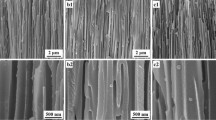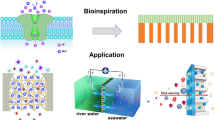Abstract
The combination of biomimetic nanochannels and nanostructures provided a new idea for bioanalytical purposes. In this paper, we reported a self-assembled system based on the integration of anodic aluminum oxide (AAO) membranes and CuO method to fabricate CuO nanostructures in the confined area of AAO membranes. Furthermore, we investigated morphologies of the self-assembly systems by field emission scanning electron microscopy (FESEM) and characterized the type and content of microelements by energy dispersive spectrometer. Transmembrane ion current through nanochannels was tested by an electrochemical workstation, and optical properties of the self-assembly systems were characterized by ultraviolet–visible spectrophotometer. We could conclude from the results that the morphology and distribution status of CuO nanostructures are controllable, while ionic current through nanochannels and optical properties of self-assembled systems could be regulated by changing experimental parameters such as electrodeposition time, electrodeposition voltage or annealing temperature. On this base, we utilized the synergistic effect of nanochannels and nanostructures to enhance the sensitivity of biological molecules response. This study not only prepared CuO nanostructures in biomimetic nanochannels controllably, but also provided a novel application paradigm for nanochannels-nanostructures self-assembled system, which could be used for biological analysis and detection.












Similar content being viewed by others
References
T.T. Ha, N.V. Tuyen, Copper oxide nanomaterials prepared by solution methods, some properties, and potential applications: a brief review. Int. Sch. Res. Not. 2014(13), 1–14 (2014)
Y. Yecheskel, I. Dror, B. Berkowitz, Catalytic degradation of brominated flame retardants by copper oxide nanoparticles. Chemosphere 93(1), 172–177 (2013)
Q. Zhang, K. Zhang, D. Xu et al., CuO nanostructures: synthesis, characterization, growth mechanisms, fundamental properties, and applications. Prog. Mater Sci. 60(1), 208–337 (2014)
Y. Wang, D. Wang, B. Yan et al., Fabrication of diverse CuO nanostructures via hydrothermal method and their photocatalytic properties. J. Mater. Sci. Mater. Electron. 27(7), 6918–6924 (2016)
M. Yang, J. He, X. Hu et al., CuO nanostructures as quartz crystal microbalance sensing layers for detection of trace hydrogen cyanide gas. Environ. Sci. Technol. 45(14), 6088–6094 (2011)
Y. Wang, T. Jiang, D. Meng et al., Fabrication of nanostructured CuO films by electrodeposition and their photocatalytic properties. Appl. Surf. Sci. 317, 414–421 (2014)
D. Shang, Y. Ke, Y. Zhang et al., Magnetic and field emission properties of straw-like CuO nanostructures. Appl. Surf. Sci. 255(7), 4093–4096 (2009)
R.A. Nistor, G.J. Martyna, D.M. Newns et al., Ab initio theory of the pseudogap in cuprate superconductors driven by C4 symmetry breaking. Phys. Rev. B 83(14), 970–978 (2011)
M. Mojahed, S.V. Vaerenbergh, Q. Galand, Nanofluids thermal conductivity measurement in a Bénard cell. Adv. Mech. Eng. 5, 1–6 (2013)
R.V. Kumar, Y. Diamant, A. Gedanken, Sonochemical synthesis and characterization of nanometer-size transition metal oxides from metal acetates. Chem. Mater. 12(8), 2301–2305 (2000)
V. Kumar, S. Masudy-Panah, C.C. Tan et al. Copper oxide based low cost thin film solar cells, in IEEE, Nanoelectronics Conference, pp 443–445 (2013)
L.J. Zhou, Y.C. Zou, J. Zhao et al., Facile synthesis of highly stable and porous Cu2O/CuO cubes with enhanced gas sensing properties. Sens. Actuators B 188, 533–539 (2013)
Y. Tian, Y. Liu, W.P. Wang et al., CuO nanoparticles on sulfur-doped graphene for nonenzymatic glucose sensing. Electrochim. Acta 156, 244–251 (2015)
Y. Wang, T. Jiang, D. Meng et al., Synthesis and enhanced photocatalytic property of feather-like Cd-doped CuO nanostructures by hydrothermal method. Appl. Surf. Sci. 355, 191–196 (2015)
N. Liu, Fabrication of smart nanochannels and its application as biosensors. Huazhong University of Science & Technology (2015)
K.D. Liang, C.H. Huang, C.C. Lai et al., Single CuO(x) nanowire memristor: forming-free resistive switching behavior. ACS Appl. Mater. Interfaces 6(19), 16537–16544 (2014)
M. Lee, S.C. Hong, D. Kim, Formation of bamboo-like conducting carbon nanotubes decorated with Au nanoparticles by the thermal decomposition of sucrose in an AAO template. Carbon 50(7), 2465–2471 (2012)
J. Kong, T. Zhou, X. Wu et al., Confined assembly of TiO2, nanostructures in the nanochannels of AAO membrane. J. Mater. Sci. Mater. Electron. 29(6), 1–7 (2017)
T.C. Chan, Y.M. Lin, H.W. Tsai et al., Growth of large-scale nanotwinned Cu nanowire arrays from anodic aluminum oxide membrane by electrochemical deposition process: controllable nanotwin density and growth orientation with enhanced electrical endurance performance. Nanoscale 6(13), 7332–7338 (2014)
D. Han, X. Zhang, Z. Hua et al., A general melt-injection-decomposition route to oriented metal oxide nanowire arrays. Appl. Surf. Sci. 390, 760–764 (2016)
S.U. Yi-Kun, C.M. Shen, H.T. Yang et al., Controlled synthesis of highly ordered CuO nanowire arrays by template-based sol-gel route. Trans. Nonferrous Metals Soc. China 17(4), 783–786 (2007)
A. Kumar, A. Sanger, A. Kumar et al., Highly sensitive and selective CO gas sensor based on a hydrophobic SnO2/CuO bilayer. RSC Adv 6(52), 47178–47184 (2016)
Z. Sun, F. Zhang, X. Zhang et al., Chiral recognition of Arg based on label-free PET nanochannel. Chem. Commun. 51(23), 4823–4826 (2015)
R. Wang, Y. Sun, F. Zhang et al., Temperature-sensitive artificial channels through pillar[5]arene-based host-guest interactions. Angew. Chem. 129(19), 5294–5298 (2017)
C. Han, X. Hou, H. Zhang et al., Enantioselective recognition in biomimetic single artificial nanochannels. J. Am. Chem. Soc. 133(20), 7644–7647 (2011)
Acknowledgements
This work was supported by the Startup Foundation for Advanced Talents of China University of Geosciences (Wuhan) (No. 009-162301132613). The financial support was gratefully appreciated.
Author information
Authors and Affiliations
Corresponding authors
Rights and permissions
About this article
Cite this article
Chen, Q., Wang, Y., Zheng, M. et al. Nanostructures confined self-assembled in biomimetic nanochannels for enhancing the sensitivity of biological molecules response. J Mater Sci: Mater Electron 29, 19757–19767 (2018). https://doi.org/10.1007/s10854-018-0101-2
Received:
Accepted:
Published:
Issue Date:
DOI: https://doi.org/10.1007/s10854-018-0101-2




